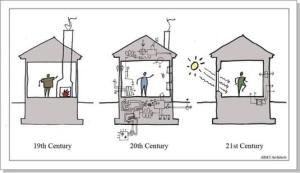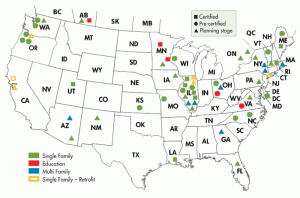Yes, really. You think the oil, coal, natural gas and HVAC companies want you to know about this. NOT. The Passive House movement is in its infancy in the US but it’s already a young adult in Europe. It’s called “passive” because heating or cooling these homes relies completely on natural resources. In other words there are no active systems involved in the 90% reduction in energy use! How is this possible I’m sure you want to know. Why didn’t I know about this might be another question.
A passive house uses orientation, super insulation, advanced window technology, air tightness, and shading to achieve standards that are set by the Passiv Haus Institute. These standards eliminate the need for a conventional HVAC system or for solar panels and geothermal systems. Although some homes have an option for solar systems. An energy recovery ventilation system provides a constant, balanced fresh air supply, a uniquely terrific indoor air quality, AND reduces energy use and carbon emissions, according to the Passive House Institute US (PHIUS)
Do passive houses cost more to build? Yep. David Peabody, a Washington metro area architect and passionate promoter of sustainable architecture and passive houses is building a passive house in Bethesda, Maryland. He found that the increased cost for the home he’s building is about 8%. For a 90% reduction in monthly energy bills I’d say it’s worth it. A certified passive house uses less than 1.4 kWh per square foot in heating and cooling energy and uses less than 11kWh per square foot for all energy! By the way, existing homes can be retrofitted to meet many passive home standards.
Barbara Landau and her family are building a second home in Vermont. A Passive House–in Vermont–with no furnace. When several insurance companies asked what kind of heating system the house would have and were told NONE, they declined to insure the house, thinking the pipes would freeze. They won’t. This excellent NY Times article chronicles their story.
The passive house movement was started when conversations between two German professors at the Institute of Housing and the Environment led to the first passive houses being built in Germany in 1990. To date it is estimated that 15 to 20 thousand passive buildings have been built worldwide, mostly in Germany and Scandinavian countries. The US numbers are far, far fewer. Remember, the movement here is still a nursing baby, but one that is being nurtured by it’s German parent.
This map represents the Passive projects currently underway in the United States today. The squares have been certified, the circles pre-certified and the triangles are in the planning stages. Green represents single family homes, red education, blue multi-family and gold are retrofits.
Buildings use more than 40 percent of all the energy consumed in the United States. If builders were to embrace the passive building concept, both the cost of building and the use of nonrenewable energy sources would decline.


Gayle, what a beautiful article!
Once people learn that passive solar homes are not new or radical but built with common sense I think we will see more people embracing the idea!
Thanks Dena. David Peabody is an acquaintance who is really the backbone of the movement towards passive houses in our area.
Great article Gayle. I first explored the passive house concept in 1981 while serving as the appointed Town Energy Coordinator for Bristol, Vermont. The project involved super-insulating a single story commercial building an a slab with a hip roof. Annual energy consumption (all utilities) were reduced by 70%. The heating system was hydronic baseboard served by a small 30,000btu tankless hot water heater. AC cooling was not needed as building temperatures remained between 70-75 degrees year round. ROI was just under 3 years.
Thanks Gene. Check out David Peabody’s blog on the house he’s building in Bethesda. He’s going to be having tours soon. Hope you’re well.
Thank you Gayle. Will be looking forward to a tour of David Peabody’s passivehaus. Whenever building or retrofitting a house for energy efficiency, attention to the climate zone is very important to prevent problems with moisture and comfort.
Gayle, thanks for the great article. I posted about this on our Earthbag Building Blog: http://earthbagbuilding.wordpress.com/
Owen thanks for your comment and for sharing my blog. I went to your blog and website briefly this morning. I will go back and once I learn a little more will certainly be sharing this concept of earth bag building. BTW, if you get a chance, go back and take another peak. I realized this morning that somehow a paragraph got deleted from the post before I published. (Embarrassed) It’s about a family building a passive house in Vermont and there’s a link to a great NY Times article.
Gayle, I also enjoyed the NY Times article and turned it into another blog post. Thanks for the heads up.
The main point of this recent post is to explain that yes, passive homes do work, but you can achieve even more by building with lower cost materials such as earthbags and straw bales. (And yes, you can get engineering and code approval.)
Morning Gale,
We are building our first model home for the Hunt Instute Engineering and Humanity Week on the SMU campus April 11th thru 15th.
The original impetus for coming up with the recycled plastic block (Ubuntu-Blox, check us out on fb and wiki ubuntu) was to create commerce in the poorest of the poor communities in the world by converting all plastic trash into building blocks to make better housing. This was a reaction to a personal challenge from Ronald Omyonga who is an architect in Nairobi, Kenya that travels extensively for Engineers without Borders.
After we were invited to participate in the H-I engineering and humanity week we decided to make those blocks out of plastics that aren’t conventionally recycled curbside here in North Texas. So the blocks we are using for the model are made from foam plastics and film plastics. We’re saving products made from Styrofoam and stuff like shrink wrap and those Walmart bags we love to hate from landing in our landfills and landscape. We are not only building a good home, we are recycling plastic waste by making blocks made with a machine that requires no electricity or motors that run on gas or diesel. The machine that makes the Ubuntu-Blox is manual and designed to be gender neutral. It uses manual dexterity instead of brute strength. The machine and the home building encourage collaboration, ubuntu in action.
One thing everyone who handles one of these blocks immediately points out is the R value has to be huge. You are looking at about a half of a large lawn debris bag of foam plastics and fifteen to twenty five grocery bags compressed into a block 8″ X 16″ X 8″. The weight is two pounds or less.
OU has invited us to bring our blocks and building system ( as unique as the Ubuntu-Blox) to Norman, OK for structural engineering tests. We hope that will give us the numbers that the engineers want and need to rate our concepts.
Wouldn’t it be wonderful to have a method of building super insulated homes for not only the rich but also the poorest of the poor? That is our dream.
Pingback: GO EcoGayle! | jpsamurai